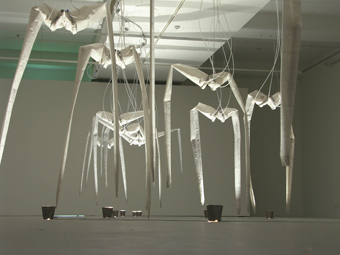 |
Chico MacMurtrie, Inflatable Bodie photo Duke Albada |
The cones are also mechanically inflated, but at periodic intervals the air supply is reduced so that they slowly collapse and droop towards the floor, whereupon the stationary flock comes to resemble a gigantic, disjointed centipede. A computer program controls the flapping and the 20 minute cycle of collapse and regeneration. The movements of each ‘bird’ are slightly asynchronous, imparting a degree of individuality to each specimen. The gallery lights are dimmed so that the birds are illuminated by 14 small spotlights on the floor beneath them, their shadows cast on the ceiling rather than the ground. I sat on the floor of the otherwise empty gallery watching the slow flapping and the gradual collapse and reinflation of the white forms, accompanied by the susurrations of the air pumps, meditating on the vulnerability of wildlife and on how art might imitate nature given the complexity and genius of biological design.
In the days preceding the exhibition, MacMurtrie held a workshop at the EAF. The participants assisted in the realisation of Inflatable Bodies and also conducted their own experiments with robotic technologies. MacMurtrie is the founder and Artistic Director of Amorphic Robot Works (ARW), a New York-based collective of artists and engineers established in 1992. ARW’s central idea is to develop robotic forms that mimic or reflect human, animal or plant forms and movement. For example, an earlier ARW work, Growing Rain Tree (installed at the Contemporary Arts Center UnMuseum, Cincinnati, 2003) is a robotic tree that moves its limbs and rains water that is drawn up from the pool in which it sits. Like many ARW works, it is interactive in that the approach of viewers triggers action. MacMurtrie has also made robots that not only respond to the viewer presence but also mimic their movement, creating a metaphor for human interaction (www.amorphicrobotworks.org).
But why is this an exhibition of art more than of engineering? MacMurtrie notes that robotics is more commonly associated with high-tech industrial development where the emphasis is on the refinement and control of manufacturing processes. Here, the robotic forms are instead intended for contemplation—he describes them as analogues of observed behaviour, emphasising the desire to understand the movement of the body and the significance of that movement rather than the use of technology for technology’s sake. The work’s engineering and computer programming are not immediately noticeable, perhaps prompting the viewer to think as much about what it symbolises as how it functions.
Inflatable Bodies thus recalls Da Vinci’s drawings of human and avian anatomy and his flying machine designs, Renaissance ideas that preceded a period of intense scientific development in the West. MacMurtrie’s work contrasts with the nightmare of Frankenstein’s monster and the inhuman creations of the 2001: A Space Odyssey, Star Wars, Terminator and Blade Runner movies. In the Adelaide Festival MacMurtrie’s peaceful work also contrasted with the dramatic use of robotic prostheses in Australian Dance Theatre’s apocalyptic Devolution (see p 32 and RT 71, p 2). We recall Isaac Asimov’s 3 laws of robotics—especially that robots must do what they’re told but never harm a human. Robots can mimic physical action and basic deductive and computational processes, but we may not be far from the mimicry of emotional states and the integration of these with decision-making and action at large. Art’s crucial role in examining the forms and implications of technological change has been central to recent EAF programming. Robotic art has the potential to examine human behaviours, attitudes and desires from an advanced technological perspective.
The cyclic movements and the expanding and collapsing forms in Inflatable Bodies induce a degree of melancholia if viewed for an extended period. I almost wanted to stand and flap my arms in sympathy.
Chico MacMurtie, Robotic Arts, Inflatable Aestheticism; Experimental Art Foundation, Adelaide Festival, Feb 24-April 8
RealTime issue #72 April-May 2006 pg. 27
© Chris Reid; for permission to reproduce apply to [email protected]








 back
back